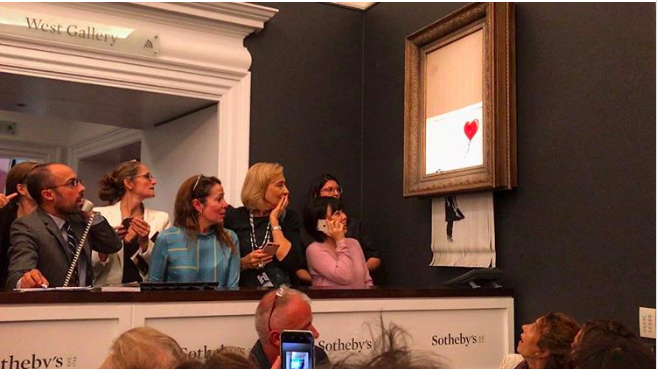
Banksy upstaged London’s busiest art week on Friday evening, when a version of his famous artwork Girl With a Balloon self-destructed just as it hammered for $1.4 million at Sotheby’s. While onlookers appeared shocked by the incident, staff were quickly on hand to move the framed and partially shredded work backstage.
In the days after the sale, artists, commentators, and market figures have been abuzz about the significance of the act. The artist Gavin Turk, who stayed in Banksy’s Walled Off Hotel on the West Bank Bethlehem, tells artnet News that the event made him smile. “Somehow I wanted the work to fly upwards into the shredder with the hot air balloon,” adding that it “appeared like a well-executed piece of theater.”
Banksy has never been afraid to riff on art history, and Turk placed this latest stunt in the tradition of auto-destructive art, a movement sparked by the destruction of World War II. “Bring back [the movement’s founder] Gustav Metzger!” Turk exclaimed.
Meanwhile, some are taking the stunt more literally than the artist may have intended. Since the event, Joey Syer, co-founder of MyArtBroker, an online art marketplace that sells works by Banksy, says his website has received inquiries from sellers wondering whether shredding their own prints might increase their value. One eager owner, he says, already jumped the gun—reducing their £40,000 unsigned print to a value of £1.
Soon after the auction, Banksy posted a video on Instagram giving context to the long con, writing, “A few years ago I secretly built a shredder into a painting in case it was ever put up for auction.”
Not everyone believes Banksy acted alone, however. Broadcaster and art historian Bendor Grosvenor described the incident on Twitter as fun, and “clever even,” but dismissed it as a public relations stunt. He wondered how a battery installed “in 2006,” when the work was first made, could magically last until 2018, adding that the whole thing offered “a glimpse into contemporary art-market hypocrisy.”
A Sotheby’s spokeswoman stressed that the auction house “had no prior knowledge of the event” and was “not in any way involved.” Alex Branczik, Sotheby’s European head of contemporary art, said in a statement, “We are busily figuring out what this means in an auction context.” The company added that it is in discussions with the successful purchaser about next steps.
The viral incident has prompted speculation from all sides about how it will affect the value of the work. Some believe the notoriety of the “happening” will increase its price. The publicity is certainly unlikely to harm the artist’s market, which is down from its high in 2008. The elusive street artist’s auction record was set a decade ago, when his riff on Damien Hirst, Keep It Spotless (2007), sold for $1.87 million at Sotheby’s New York.
Variations of the work shredded at Sotheby’s, which depicts a young girl letting go of a heart-shaped balloon, have come to auction 27 times in the past, according to the artnet Price Database. (Although the original version on the streets of London no longer survives, the artist created paintings of the work in 2003 and released a series of prints the following year.) The second most expensive work from the series—achieved for a print from an edition of 25—was sold at Bonhams London in March for $478,819. The work was also voted the UK’s most popular artwork last year, overtaking John Constable’s 1821 painting Hay Wain in the hearts of the British public.
“Girl with Balloon is one of the most iconic images of recent times,” says Joey Syer of MyArtBroker. Now, the work’s renown is likely only to grow. “Given the media attention this stunt has received, the lucky buyer would see a great return on the £1.02 million they paid [on Friday] this is now part of Art History in its shredded state and we’d estimate Banksy has added at a minimum 50 percent to its value, possibly as high as being worth £2 million,” he says.
Elsewhere, conspiracy theories abound. One eagle-eyed Twitter user suspects it was all an elaborate parlor trick. He points out that the shredded work is not in line with the painting supposedly being swallowed, suggesting that the street artist actually shredded a copy of the work and not the original. “If you look closely, the shredded print is at an angle to the original print—the head is out of sync with the body,” writes Steve Bowler. “It’s possible the original was rolled up at the end of the frame while the copy was sent through the shredder or pre-shredded.”